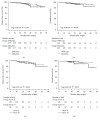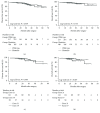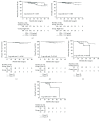Epidermal Growth Factor Receptor Mutations and Their Prognostic Value with Carcinoembryonic Antigen in Pathological T1 Lung Adenocarcinoma
- PMID: 29849818
- PMCID: PMC5941781
- DOI: 10.1155/2018/2942618
Epidermal Growth Factor Receptor Mutations and Their Prognostic Value with Carcinoembryonic Antigen in Pathological T1 Lung Adenocarcinoma
Abstract
Aims: The prognostic value of epidermal growth factor receptor (EGFR) mutations in the context of serum carcinoembryonic antigen levels remains controversial in T1 lung adenocarcinoma.
Methods: Clinical and pathological characteristics, preoperational carcinoembryonic antigen levels, EGFR mutations, and disease-free and overall survival were analysed retrospectively in 573 pathological T1 patients in East China.
Results: EGFR mutations were detected in 220 of 573 patients (38.4%). Patients with serum carcinoembryonic antigen levels ≥ 2.12 ng/mL had worse disease-free (P < 0.001) and overall survival (P < 0.001) than had others, although survival was comparable between patients with and without EGFR mutations. However, patients with exon 21 mutations in EGFR had significantly better overall survival than had patients with exon 19 mutations (P = 0.016), although disease-free survival was comparable (P = 0.424). Among patients with serum carcinoembryonic antigen levels ≥ 2.12 ng/mL, disease-free (P = 0.019) and overall survival (P < 0.001) was also better than that in those with exon 21 mutations. Finally, the exon 19 deletion was found to be an independent predictor of unfavourable overall survival (P = 0.037).
Conclusions: EGFR mutations were associated with preoperational serum carcinoembryonic antigen levels ≥ 2.12 ng/mL. In patients with levels above this threshold, those with the exon 19 deletion have less favourable prognosis than have those with the exon 21 mutation.
Figures





Similar articles
-
Correlation between serum CEA levels and EGFR mutations in Chinese nonsmokers with lung adenocarcinoma.Acta Pharmacol Sin. 2014 Mar;35(3):373-80. doi: 10.1038/aps.2013.164. Epub 2014 Feb 3. Acta Pharmacol Sin. 2014. PMID: 24487967 Free PMC article.
-
Serum carcinoembryonic antigen levels before initial treatment are associated with EGFR mutations and EML4- ALK fusion gene in lung adenocarcinoma patients.Asian Pac J Cancer Prev. 2014;15(9):3927-32. doi: 10.7314/apjcp.2014.15.9.3927. Asian Pac J Cancer Prev. 2014. PMID: 24935562
-
Elevated serum CEA levels are associated with the explosive progression of lung adenocarcinoma harboring EGFR mutations.BMC Cancer. 2017 Jul 14;17(1):484. doi: 10.1186/s12885-017-3474-3. BMC Cancer. 2017. PMID: 28705152 Free PMC article.
-
Monitoring of carcinoembryonic antigen levels is predictive of EGFR mutations and efficacy of EGFR-TKI in patients with lung adenocarcinoma.Tumour Biol. 2014 May;35(5):4921-8. doi: 10.1007/s13277-014-1646-1. Epub 2014 Jan 24. Tumour Biol. 2014. PMID: 24459065
-
Value of ¹⁸F-FDG uptake on PET/CT and CEA level to predict epidermal growth factor receptor mutations in pulmonary adenocarcinoma.Eur J Nucl Med Mol Imaging. 2014 Oct;41(10):1889-97. doi: 10.1007/s00259-014-2802-y. Epub 2014 May 23. Eur J Nucl Med Mol Imaging. 2014. PMID: 24852187
Cited by
-
Potential prognostic value of the lymph node ratio and its correlation with circulating sex hormone concentration in pathological T1/2 breast cancer patients: a retrospective study.Ann Transl Med. 2022 May;10(10):585. doi: 10.21037/atm-22-2039. Ann Transl Med. 2022. PMID: 35722397 Free PMC article.
-
Clinicopathologic Features and Molecular Biomarkers as Predictors of Epidermal Growth Factor Receptor Gene Mutation in Non-Small Cell Lung Cancer Patients.Curr Oncol. 2021 Dec 24;29(1):77-93. doi: 10.3390/curroncol29010007. Curr Oncol. 2021. PMID: 35049681 Free PMC article. Review.
-
Guanylate-binding protein 1 correlates with advanced tumor features, and serves as a prognostic biomarker for worse survival in lung adenocarcinoma patients.J Clin Lab Anal. 2021 Feb;35(2):e23610. doi: 10.1002/jcla.23610. Epub 2020 Dec 10. J Clin Lab Anal. 2021. PMID: 33301214 Free PMC article.
-
Clinical impact of pleural fluid carcinoembryonic antigen on therapeutic strategy and efficacy in lung adenocarcinoma patients with malignant pleural effusion.Korean J Intern Med. 2024 Mar;39(2):318-326. doi: 10.3904/kjim.2023.309. Epub 2024 Feb 14. Korean J Intern Med. 2024. PMID: 38351680 Free PMC article.
References
-
- Hung J. J., Yeh Y. C., Jeng W. J., et al. Predictive value of the International Association for the Study of Lung Cancer/American Thoracic Society/European Respiratory Society classification of lung adenocarcinoma in tumor recurrence and patient survival. Journal of Clinical Oncology. 2014;32(22):2357–2364. doi: 10.1200/JCO.2013.50.1049. - DOI - PubMed
MeSH terms
Substances
LinkOut - more resources
Full Text Sources
Other Literature Sources
Medical
Research Materials
Miscellaneous

